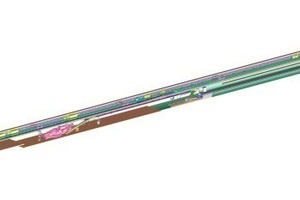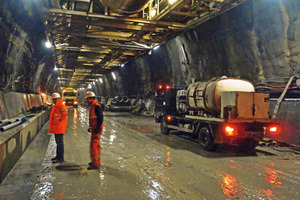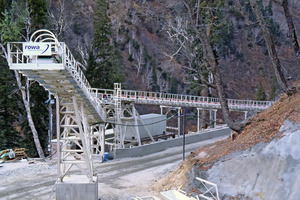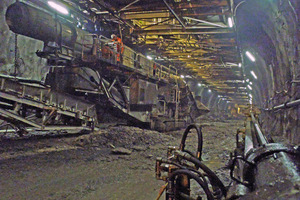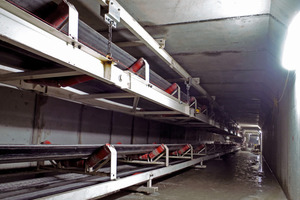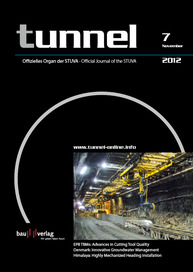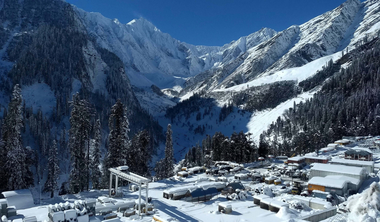Application of Alpine Tunnelling Experience for Highly Mechanized Conventional Heading in the Himalaya
The Rohtang Pass Highway Tunnel is being built under difficult conditions using the conventional sectional heading method. Geological as well as deadline challenges necessitate sectional headings and invert lining to be carried out simultaneously, using a tailor-made, highly mechanized heading installation. This leads to rationalized work flows and, therefore, to significant productivity increase. Moreover, all participants will benefit from more human work places as well as increased work safety.
Rohtang Pass Highway Tunnel
At 3,980 m a.s.l., the Rohtang Pass is among the highest mountain passes fit for traffic worldwide and represents the only road connection from the North Indian province Himachal-Pradesh to the boarder region Ladak. Each year during winter blockade, every community of the Western Himalaya to the north of the mountain pass is cut off from the rest of the country for 4, often even 6, months because of heavy snowfall and violent storms.
In September of 2009, the Border Roads Organization received the order from the Indian Government to commission Strabag AG/Afcons Joint Venture with the construction of the 8.8 km long Rohtang pass highway tunnel, approx. 3,100 m a.s.l. This will make the Manali-Leh-Highway fit for traffic during the entire year, thereby shortening the drive through the narrow and dangerous mountain pass by several hours.
The horseshoe-shaped tunnel will offer enough space for an 8 m wide two-lane road, as well as a 1 m wide footpath on either side. Underneath the main road, a 2.25 m high and 3.6 m wide escape tunnel will be integrated into the tunnel cross section. Heading started from both portals. Because the northern portal is not accessible during winter months, the heading will be concentrating on the southern portal.
Particular challenges of this project are the altitude, extreme climatic conditions, as well as the geological conditions of the Himalaya. The overburden is 600 m on average and 1,900 m maximum. Three fault zones are expected, as well as squeezing rock conditions in certain areas. For this reason, the owner and the project designer have opted for a conventional heading method, which will enable flexible adjustment of the heading, as well as the rock support and safety methods in the different rock formations [1]. Additional challenges for the heading are the removal of more than 800,000 m3 of muck, as well as major inrush of water (up to 3 million l/day in June 2012).
Simultaneous heading in crown and bench/invert as well as rapid ring closure
Due to the very large cross section of up to nearly 135 m2, and because of the geological conditions, sectional heading is applied. In a first step, the crown with approx. 83 m2, and in a second step the bench with roughly 33 m2 are broken loose with loosening blasting. Then, the invert is broken out. Rock support measures comprise rock bolts, fiber-reinforced shotcrete and - according to rock class – the installation of steel arches.
To achieve early ring closure, breakout and rock support measures in the bench and invert areas must immediately follow the crown heading. In addition, the prefabricated elements of the escape tunnel must be installed. Without special measures and equipment, supply and removal logistics of all work levels would become a very complex challenge and represent the limiting factor for heading performance.
For this purpose, the Strabag AG/Afcons Joint Venture aimed for highly mechanized drill and blast heading and gave Rowa Tunnelling Logistics AG the order to develop, produce, supply, assemble and start up a tailor-made heading installation.
Draft of heading installations
When planning the heading installations in close cooperation with the customer, Rowa was able to make use of experience and valuable insight gained from other heading mechanization projects in tunnelling construction. In this context, experiences made with suspended work- and heading-platforms from the Mitholz section of the Lötschberg Base Tunnel, from the Sedrun section of the Gotthard Base Tunnel [2], as well as from the main headings of the Ceneri Base Tunnel [3], could be used for the heading installations of the Rohtang Pass Highway Tunnel.
The flow of material within the linear construction site is supported by a highly mechanized, 370 m long heading installation. It basically consists of 2 jaw crushers, a heading platform on suspension tracks with its installations and infrastructure, as well as 3 towing conveyors and 1 continuous conveyor (Figure 1).
Crown heading, bench and invert breakout, as well as the installation of the escape tunnel, are independent construction sites for the most part; their performance may differ from the regular heading process. In order to minimize the interdependencies, the selected platform length allows for a relative difference of 60 m between work places, without problems.
Simultaneous trailing of complete infrastructure and sufficient room for construction equipment
All infrastructure installations can be placed onto the heading platform. They are, in particular, a dedusting unit, the ventilators for fresh air, for blowing and suction ventilation, air compressors, transformers for conversion of medium voltage, an emergency generator, a concrete pump, a high voltage cable drum as well as a fresh water hose drum. In addition, the platform contains a container for the heading management, a container for personnel, a workshop container and a storage container, fuel tanks, additives tanks as well as an air duct cassette.
The heading platform moves on suspension tracks suspended from the vault with chains and special adaptors to friction rockbolts. The entire heading installation can be pulled forward at the touch of a button and according to the heading progress. Four platform sections with a pair of stepping devices each and corresponding dilatation areas can be controlled according to the sliding-floors-principle.
Below the heading platform on the invert, the tunnel constructors have a second working level and free floor space for working, manoeuvering and parking at their disposal (Figure 2). Working safety has been increased substantially thanks to clearly arranged space conditions, the rationalization of work flows and the generous illumination.
Blowing and suction ventilation provides fast access to rock face and health protection
Optimal ventilation and cooling are important measures to guarantee health protection and work safety in tunnel headings.
Fresh air is sucked in at the portal and blown via air ducts with 2,800 mm diameter to the rear of the heading platform. Here, part of the fresh air is picked up with a ventilator and transferred to the front of the platform by an air duct of 2,000 mm diameter.
For the efficient flushing of blasting fumes, additional air is blown to the rock face with a dedicated ventilator and an air duct of 900 mm diameter, suspended from the left suspension track. On the right side, next to the blasting protection, the blasting fumes are vacuumed off with a suction ventilator as well as the deduster and transferred with 2 air ducts of 900 mm diameter to the rear of the heading platform.
The tunnel constructors of the crown and bench/invert headings and the workers of the rear invert and escape tunnelling construction sites are, therefore, rarely exposed to unhealthy blasting fumes, while the additional ventilation platform enables a fast clearing of the rock face for muck removal and rock support work.
Jaw crushers, towing conveyors and continuous conveyor for removal logistics of the 3 headings
Rowa Tunnelling Logistics AG and their client, Strabag AG/Afcons Joint Venture, have implemented a logistics system which allows for direct material transport from the rock face all the way to the discharge tower of the intermediate muck disposal site at the touch of a button (Figure 3).
The excavated material is transported after every blast from the rock face of the crown heading by a wheel loader with side tipping bucket over a distance of 50 to 70 m to the mobile crawler type crusher (Figure 4).
The muck crushed by the jaw crusher, with a maximum grain size of 200 mm, is transferred onto the ascending area of the 217 m long towing conveyor placed on the hanging platform.
Simultaneously, a second identical jaw crusher is loaded with material from the bench, and from the invert breakouts, respectively (Figure 5). The material is loaded onto a second 110 m long movable (60 m travelling distance) towing conveyor suspended from the hanging platform.
Both towing conveyors drop the excavation material onto a third, 245 m long towing conveyor suspended from the prefabricated elements of the escape tunnel and transporting the material to the continuous conveyor installed in the escape tunnel (Figure 6). Thereby, the entire carriageway is free of equipment and the lining work can proceed without interruption. The continuous conveyor is elongated every 200 m.
Heavy duty crane, material handling cranes and various pipelines ensure direct supply of the headings
A self-propelling heavy duty crane with a load capacity of 12 t guarantees the supply of rock support material, operational and wear and tear material as well as explosives across the invert construction site to the crown, respectively bench headings. The material is delivered by trucks driving on the completed escape tunnel. Any stop on the way to the rear of the jaw crusher of the bench breakout can be supplied with material. From this point, a travelling crane with 2 x 1.6 t load capacity serves as supply unit for the crown heading. A cross travelling electric chain hoist with 1.6 t load capacity is placed behind the ascending area of each towing conveyor for handling of materials. A lengthwise travelling electric chain hoist takes care of handling of materials from the transport vehicles to the suspension platform and to the storage/workshop container.
Shotcrete for rock support is supplied via truck to the rear of the heading platform, and transferred with 2 shotcrete pumps to the invert construction site, or to the rear of the jaw crusher of the crown heading. A switch in the concrete pipes enables an efficient redirection between the 2 receiving areas. Additives for shotcrete are equally supplied via truck and transferred through pipes into the 2 additives tanks on the heading platform. Fuel for construction machines can also be transferred and stored temporarily in 2 fuel tanks on the heading platform.
Fresh air and electrical power are continuously supplied via the tunnel mains and distributed to all the users on and below the heading platform via hose drum, high voltage cable drum, water conduits and electric installations.
Construction of invert area with self-propelling shotcrete manipulator, heavy duty crane and travelling crane
A self-propelling shotcrete manipulator suspended from the heading platform reinforces walls and invert (Figure 7). The device consists of a chassis with integrated lengthwise traction drive, and a swiveling and telescopic spraying arm. The shotcrete manipulator can be employed on a 60 m long platform section; its working area covers 12 m and 210°. The appropriate shotcrete pump with additives tank is located above on the heading platform. The same installation allows for the provision of invert concrete for the escape tunnel at a later stage. For this very exposed construction site, robust construction and simple operation were major factors which had to be considered during planning [4].
The prefabricated elements for the escape tunnel delivered by truck are transferred and installed with the heavy duty crane previously mentioned (Figure 8). For this purpose, it can travel 1 m crosswise.
After the invert area next to the escape tunnel has been filled up with concrete and compacted in layers, the kickers can be effected with insitu concrete. A cross- and lengthwise travelling crane suspended from the heading platform is used for transferring installation material, as well as repositioning the formwork. The same crane (loading capacity of 2 x 2.8 t) can install prefabricated line segments at a later stage (Figure 9).
Early Experiences
Until June 2012, approx. 3.5 km of tunnel were excavated. Upon completion, the Rohtang Pass Highway Tunnel with its 8.8 km will undoubtedly be the worldwide longest tunnel located above 3,000 m a.s.l.
In the past months, all functions of the heading installation supplied by Rowa Tunnelling Logistics AG could be put into operation successfully. Even though the learning phase is far from completion, the entire system has proven to be satisfactory even under such difficult conditions. The chosen construction enables sectional headings and invert lining to be carried out simultaneously. This ultimately makes it possible to keep the deadline of this project – provided geology will match the expected conditions.
With the illustrated installation, Rowa Tunnelling Logistics AG carries on to pursue the continuous development of mechanization in tunnelling construction. It will lead to a rationalization of work flows and, therefore, to a significant increase in productivity. And last but not least, all persons involved will profit from more humane work places and increased work safety.

